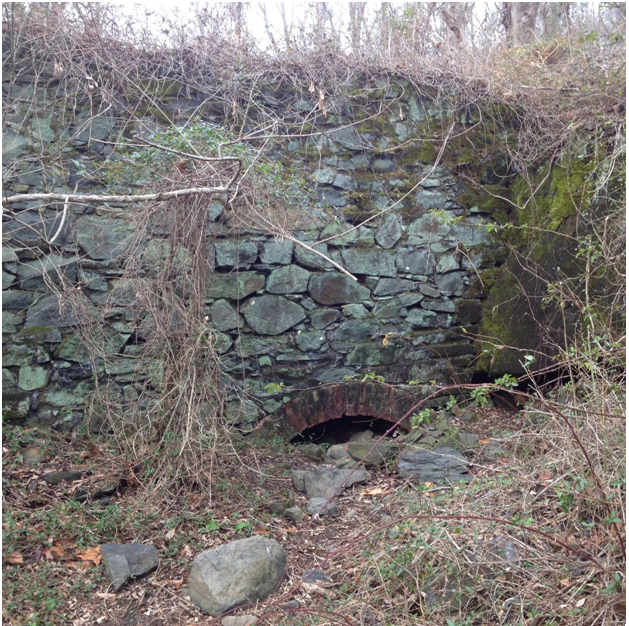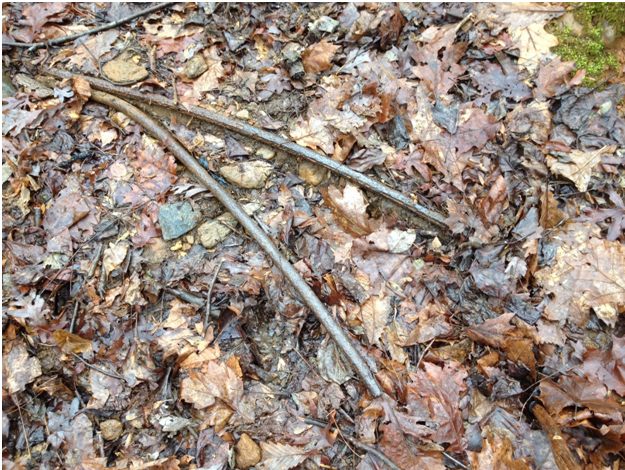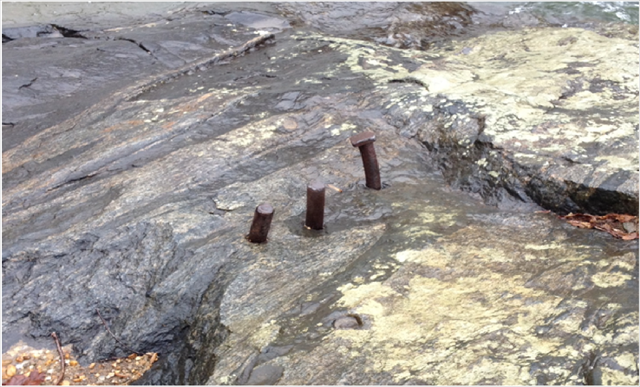While my railroad is a freelanced fictional road, it has its basis in history. For a number of years I lived in the area of the historic Joppa Iron Works site- the entire area did not have any very old trees (evidence of logging for charcoal) and it was not difficult to find slag in simple tasks like gardening.
Originally the company existed to make nails on the Gunpowder River in Eastern Baltimore County, Maryland. What would have happened if the company survived the 1800′s into the 1900′s? What if they had been able to survive late into the last century? Certainly they would have had to upgrade the facilities and add new technology beyond the colonial style furnaces that they originally used.
Prior to the damming of the Gunpowder, larger vessels were able to navigate far up the river since it had access to the Chesapeake Bay. The Joppa Iron Works used the high volume of water flowing down the Gunpowder to power its water wheel- which in turn operated the furnace bellows.
Below is my original submission onto Wikipedia based on my own research- which is brief compared to the original information and other associated history with the mill:
“The Joppa Iron Works also known as Patterson’s Iron Works was started around 1817 by Joseph and Edward Patterson of Baltimore who were the brothers of Elizabeth Patterson Bonaparte – who was the sister-in-law of Napoleon I of France. Built on the “Long Calm” portion of the Big Gunpowder River in eastern Baltimore County, MD this facility was started as a slitting and nail producing company. Located approximately .75 of a mile below the Maryland Route 7 this facility eventually had six puddling furnaces, one heating furnace, and 37 nail machines with all of the machinery being water-powered[1].
The Joppa Iron Works were on the Great Gunpowder not quite a mile from its embouchure and near Divers Island. They were operated up to the commencement of the civil war and their product was well known in all the markets. They consisted of a large rolling mill nail works and forges. First-class vessels came up the river to the island and the embankments for the wharves are still visible. Where the main channel of the Gunpowder once was and where sea going ships rode at anchor is now a corn field on the Mount Peru estate. One rolling mill an immense stone structure abandoned more than twenty years ago still stands and is almost covered by the rank luxuriance of the Virginia creeper. The works were owned and operated by that Patterson family of which Madame Elizabeth Patterson Bonaparte was a member, who sold the whole tract of one hundred and thirty four acres known as Bald Hill to the city of Baltimore for water privileges for twenty thousand dollars. The city resold it and it is now the property of Levi Furstenburg.—History of Baltimore City and County[2], John Thomas Scharf, 1881
There are few remnants of the iron works that remain except for a large flat area where the business stood. Prior to the original dam being built at the Loch Raven Reservoir in 1881, the water depth at the Joppa Iron Works site was much deeper facilitating shipments in and out of the area by deep-water vessels. As late as the 1970s, an old ship’s mooring ring was able to be seen in the area. Remnants of slag from the furnaces can still be found in the area.
The Joppa Iron Works eventually closed around 1865 with the death of Edward Patterson. The Loreley Distilling Company eventually purchased the property and distilled whiskey on the site after Prohibition, and eventually sold to the Frank L. Wight Distilling Co. – part of Heublein Inc. The distillery was then purchased by Hiram Walker & Sons of Canada and subsequently shut down when production moved to their Peoria, Illinois facility.
In 1970 this property was acquired by the Department of Forest & Parks Maryland and is now part of the Gunpowder State Park.”
More detailed history has been located online and details a walking journey. Here it is:
If you follow the trail along the river’s edge, when it starts to go uphill past the CSX bridge (formerly B&O Railroad, built in 1883), you will find the remains of an old puddling furnace (built after August 1832), at N 39° 24.751 W 076° 23.681, when a fire consumed the whole factory.




As for bending history, on my railroad, the business never closed, but grew and expanded in the area with a proximity to Baltimore. While the representative city area on my railroad has a few key elements from Baltimore, it is not modeled after any particular area but tries to get a general feeling. One of the city buildings I modeled after the original Matheson Building:
My structure is a series of color prints over a FomeCore sub structure as are many of my city buildings. Some were built using Mike Palmiter’s technique of a Plexiglas structure finished with card stock and automotive striping tape. Here is an example if his work:
http://www.thetrainexchange.net/mikepix.htm
Below is one example of a plexiglas core building with a card stock overlay exterior. As time progresses, structures will improve – as it is the railroad has been up for 3 1/2 years (as of 2-2012):

The colonial furnaces in the area were built on a top loading design and operated until the furnace either ran out of fuel or needed repair. Furnace start up was called “blowing in” and ceasing of operation was called “blowing out” the furnace. This term has carried forward until today; usually when a furnace was blown out, there was a celebration for the profit and operations- and parties today can still be referred to as a “blow out”.